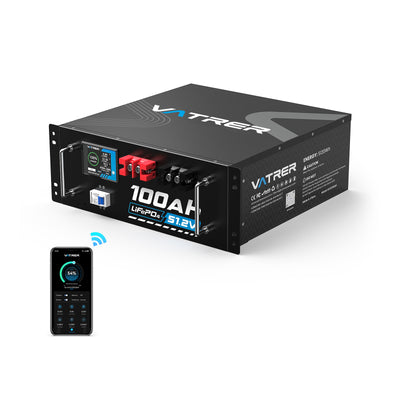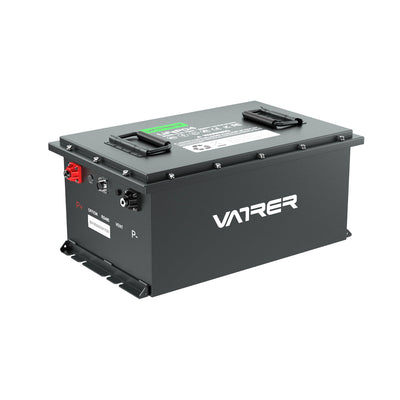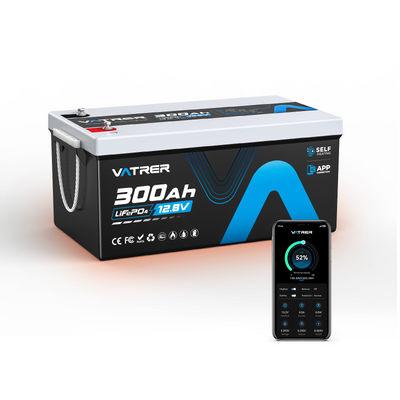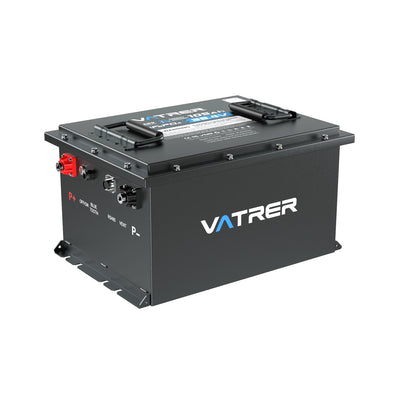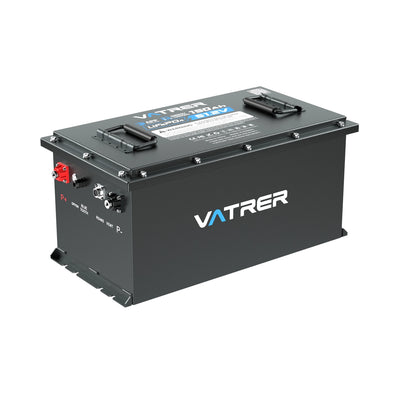
What is BMS on a Lithium Battery and Why Is It So Important
Lithium batteries are known for being lightweight, efficient, and long-lasting compared to traditional lead-acid batteries. But this advanced chemistry comes with higher sensitivity to how the battery is charged, discharged, and operated. If a lithium battery is overcharged, deeply discharged, or exposed to extreme temperatures, it can suffer permanent damage or even trigger a thermal runaway, a chain reaction of overheating that can lead to failure.
That’s why every modern lithium battery needs a Battery Management System (BMS), the “brain” that keeps the battery safe, efficient, and reliable. A lithium battery BMS constantly oversees the battery pack, ensuring every cell operates within safe limits while optimizing performance and extending lifespan.

What Is a BMS and How Does It Work
A Battery Management System (BMS) is an electronic circuit built into or connected to a rechargeable battery. It performs continuous monitoring of voltage, current, temperature, and the overall health of the battery cells.
In simple terms, the BMS monitors each cell, calculates safe charging and discharging levels, and controls how energy flows in and out of the battery pack. When it detects abnormal conditions, like over-voltage, overheating, or short circuits, it immediately takes corrective action, such as cutting off the current or regulating power.
You can think of it as a monitoring and control center that prevents misuse and protects the battery from unsafe operation. Without it, even the best lithium battery could degrade quickly or fail catastrophically.
Core Functions of a Battery Management System
A BMS typically performs three critical functions: Monitoring, Protection, and Optimization. Each is essential to keeping your lithium batteries safe and performing at their best.
1. Monitoring — Real-Time Health Check
The BMS performs continuous monitoring of several parameters:
- Voltage: keeps each cell within a safe range.
- Current: prevents overload during charge or discharge.
- Temperature: monitors the temperatures to avoid charging when it's too cold or discharging when it's too hot.
- State of Charge (SOC): shows how much usable energy remains.
- State of Health (SOH): indicates how the battery has aged over time.
This data allows the system to know exactly when to stop charging or discharging before any permanent damage occurs, ensuring safe and stable operation.
2. Protection — Preventing Damage and Hazards
One of the most vital jobs of a battery management system BMS is to act as a safety shield. It prevents harmful events like overcharging, over-discharging, and short circuits that can destroy a battery pack.
| Protection Type | What It Does | Why It Matters |
|---|---|---|
| Overcharge / Over-Discharge | Stops charging above safe voltage or discharging too deeply. | Prevents cell swelling, gas release, and chemical imbalance. |
| Short Circuit Protection | Detects extreme current spikes and cuts power immediately. | Avoids fires and thermal runaway. |
| Temperature Control | Adjusts or halts charging when outside the safe range (typically 32°F–113°F). | Prevents low-temperature plating and overheating failures. |
Tips: Never bypass or modify a BMS to get “more power.” Doing so disables critical safety functions and voids any warranty.
3. Optimization — Smart Balancing and Efficiency
Over time, individual battery cells can become slightly unbalanced due to self-discharge and aging. A BMS maintains performance through cell balancing, keeping every cell at similar voltage and capacity levels.
There are two main types:
- Passive Balancing: dissipates energy from higher-voltage cells until they match the lower ones.
- Active Balancing: redistributes charge between cells for improved efficiency.
Balanced cells improve battery performance, extend usable capacity, and reduce wear, helping your battery deliver consistent power for years.
Maintaining the Optimal Temperature Range of the Lithium Battery BMS
Temperature is one of the most critical factors in battery health. A well-designed BMS helps the battery maintain an ideal thermal range, not too cold, not too hot.
At low temperatures (below 32°F), charging can cause metallic lithium plating on the anode, which permanently reduces capacity. At high temperatures (above 113°F), the battery may lose up to 50% of its efficiency and degrade much faster.
Modern systems use thermal management techniques such as:
- Passive cooling through airflow or conductive materials.
- Active cooling with fans or liquid circulation systems.
- Self-heating modes in cold environments to raise the temperature before charging.
Maintaining this “Goldilocks zone” ensures optimal efficiency, safety, and cycle life.
Types of Battery Management Systems
Different applications require different BMS configurations. Below is a simplified comparison of the types of battery management systems commonly used today:
| BMS Type | Description | Key Advantage | Trade-Off |
|---|---|---|---|
| Centralized | A single controller manages all cells directly. | Simple and cost-effective. | Heavy wiring and harder maintenance. |
| Modular | Each module manages a section of cells, coordinated by a main controller. | Easier to scale and maintain. | Slightly higher cost. |
| Primary/Subordinate | Main BMS handles logic, secondary units collect data. | Balanced between cost and control. | Depends on main controller stability. |
| Distributed | Each cell has its own mini BMS board. | High accuracy and minimal wiring. | More expensive, harder to repair. |
| Built-in BMS | Integrated inside the battery casing. | Space-saving, plug-and-play use. | Limited customization for large systems. |
Why BMS Is So Important for Lithium Batteries
- Safety Above All
A BMS is the first line of defense against accidents. By enforcing voltage, current, and temperature limits, it prevents thermal runaway, fire, and short-circuit damage, ensuring both the battery and user stay safe.
- Consistent Performance and Range
With intelligent monitoring and control, the BMS keeps voltage and SOC balanced, delivering stable power output even as cells age. This means your devices or vehicles maintain reliable performance and range.
- Extended Battery Lifespan
Every protective action, from balancing cells to regulating temperature, directly contributes to longevity. A good BMS helps lithium batteries reach thousands of charge cycles without significant capacity loss.
- Real-Time Diagnostics and Communication
Advanced systems include Bluetooth or CAN communication, allowing users to check performance metrics, temperature, and charge status in real time through mobile apps or displays.
- Lower Total Cost of Ownership
While adding a BMS slightly increases initial cost, it dramatically reduces long-term expenses from replacements, failures, or warranty claims, making it a smart investment for any energy system.
How To Choose the Right BMS
When selecting a BMS for your lithium battery system, look for:
- Accurate sensors for voltage, currentand temperature.
- Over-charge, over-discharge, and low-temperature protection.
- Reliable cell balancing to ensure long-term stability.
- Compatible communication protocols (like CAN or RS485) if using solar or EV systems.
- Tested quality from a reputable manufacturer.
Tips: Avoid cheap, unverified BMS units, poor calibration or slow response can cause irreversible cell damage or unsafe operation.
Common Problems with Low-Quality BMS Units
A weak or defective BMS can cause more harm than good. Typical issues include:
- Inaccurate readings that miss dangerous voltage or temperature spikes.
- Slow response times, failing to stop over-current or overheating quickly enough.
- Poor cell balancing, leading to reduced capacity.
- False shutdowns that cut power even when the battery still has charge.
- Complete failure to protect, increasing the risk of thermal runaway.
In short, the reliability of your BMS work determines the reliability of your entire power system.
Conclusion
A battery management system BMS is not just an accessory, it's the foundation of any modern lithium power system. By protecting the battery, maintaining balance, and preventing permanent damage, it ensures your lithium batteries stay powerful, safe, and dependable.
If you're looking for a practical, ready-to-go option? Vatrer's lithium batteries integrate a robust built-in BMS with precise sensing, intelligent cell balancing, and protections for over-/under-voltage, over-current, temperature, and short circuit protection. That combination gives you reliable power with app-level visibility and safeguards that protect the investment for the long run. Whether you power an RV, golf cart, or solar energy system, Vatrer's smart BMS design helps you enjoy a longer lifespan, reliable energy, and total peace of mind.
FAQs
If my charger already has protections, do I still need a BMS?
Yes. A charger can limit voltage and current at the pack level, but a battery management system (BMS) works at cell level and provides continuous monitoring of each cell’s voltage, temperature, and state of charge (SOC). That cell-by-cell visibility is what prevents hidden imbalances and local overheating that a charger can’t see. The BMS also adds short circuit protection, temperature cutoffs, and controlled shutdown logic—critical safeguards during both charging and discharging. In short, the charger protects how you fill the tank; the BMS protects what’s inside the tank.
How do I size and choose the right BMS for my system?
Match the BMS to your chemistry (like LiFePO4), system voltage, and real power needs. Start with your inverter/controller’s maximum draw and your loads’ surge profile. If your inverter is 2000W on a 12V system, the continuous current can reach ~167A (2000W/12V). Choose a BMS with continuous current comfortably above that and a surge rating long enough to ride through motor or compressor startups. Look for accurate sensors, reliable cell balancing, low-temperature charge cutoff, and communication (Bluetooth, CAN, or RS485) if you want app visibility or inverter/MPPT coordination. For compact systems, a built-in BMS is plug-and-play; for large battery banks or custom racks, a modular or master/subordinate architecture scales better.
What actually happens when a BMS “shuts down” and how do I recover?
When limits are hit—low voltage, high temperature, or over-current—the BMS opens its protection MOSFETs and the pack turns off to avoid permanent damage. Recovery depends on the trigger. For low-voltage cutoff, connect a compatible charger to wake the pack and start gently; for over-temperature, let the pack cool (or warm up if too cold) before retrying; for over-current, remove the offending load, then power-cycle. If the shutdown repeats, investigate root cause: wiring gauge, loose terminals, charger settings, or a faulty device.
Tip: Many issues stem from incorrect charge limits—verify your charger’s profile matches LiFePO4 specs and the BMS’s high-voltage cutoff.
Can I use lithium batteries in cold climates without harming them?
Yes, with the right protections. Charging below freezing risks lithium plating, so a good lithium battery BMS will block charging until cells warm up. Solutions include packs with internal heaters, preheating using shore power or a DC-DC source, insulating the enclosure, and scheduling charge windows during warmer hours. For storage, leave the battery pack around 40-60% SOC and avoid prolonged extreme cold or heat.
Tip: If your site regularly sees sub-freezing mornings, consider a Vatrer battery with built-in BMS plus integrated self-heating so the system can safely warm itself before accepting charge.
How does cell balancing work, and when is active vs. passive balancing worth it?
Over many cycles, tiny differences cause cells to drift. Cell balancing brings cells back in line so no single cell limits the whole pack. Passive balancing bleeds a small amount of energy from higher-voltage cells near the top of charge—simple and reliable for most RV/marine/solar users. Active balancing shuttles charge between cells and is useful in larger or high-cycle fleets where squeezing maximum capacity matters. After replacing a pack or adding new modules, allow several full charge sessions so the BMS can complete balancing; during this period, battery performance may slowly improve as the top-end aligns.
What communication should I look for Bluetooth, CAN or RS485 and why?
Bluetooth is convenient for mobile apps and quick diagnostics (SOC, temperatures, cycle count). CAN and RS485 enable deeper monitoring and control, letting the BMS share limits with inverters/chargers and solar controllers so the whole system adapts in real time (think dynamic charge current or curtailed discharge if a cell approaches limits). Off-grid and vehicle builds benefit from CAN if you want closed-loop integration; fixed solar and rack systems often prefer RS485 for longer runs and stable networking. Choose a BMS that speaks the same language as your inverter/MPPT to avoid guesswork and alarms.
How do I minimize the risks of thermal runaway and electrical faults?
Start with a quality BMS and don't bypass it. Size conductors and fuses correctly, use clean crimps/torque settings, and secure cabling to prevent vibration-induced loosening. Keep the pack within its thermal window using ventilation, ducted fans, or liquid plates if power density is high. Set charge voltages and currents per chemistry, and enable low-temperature charge lockout. Separate high-current paths from low-voltage signal wiring to reduce noise and false trips.
Tip: Periodically review the BMS event log (if available). Repeated high-temp or over-current flags are early warnings you can fix before they escalate.
Should I choose a built-in BMS battery or an external BMS system?
For most RV, marine, golf cart, and home-solar users, a battery with a built-in BMS is simpler, safer, and faster to deploy—fewer wires, fewer variables, and the manufacturer has already matched the BMS to the cells. External or modular BMS setups make sense when you need advanced telemetry, custom limits, or large parallel strings in commercial storage. If you’re not designing a multi-rack system, built-in is usually the right call.
Share












































































